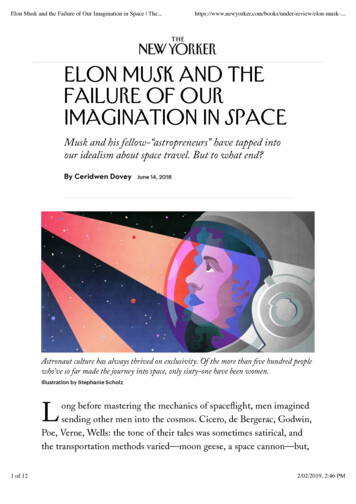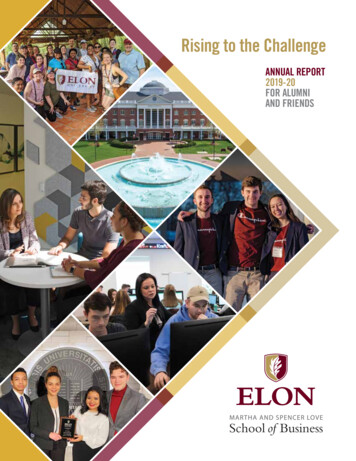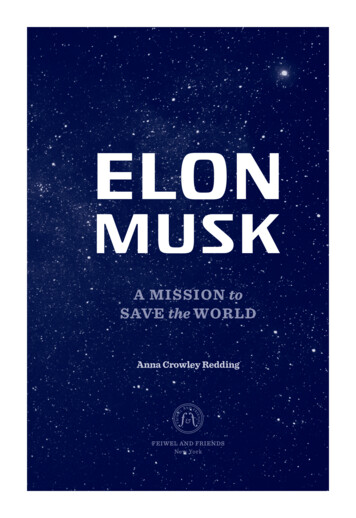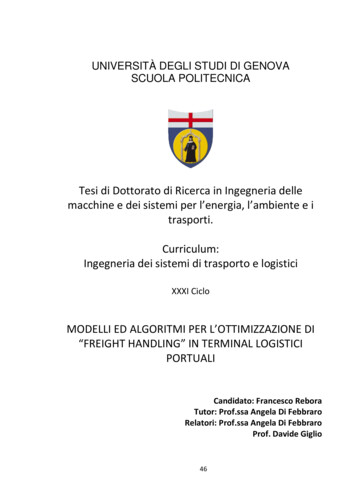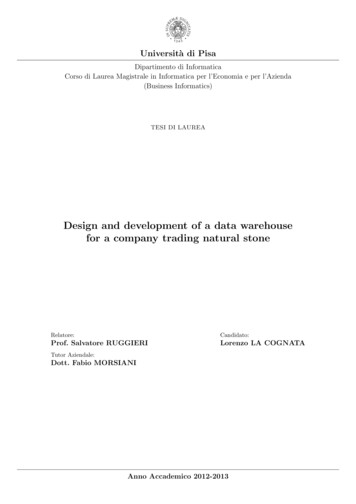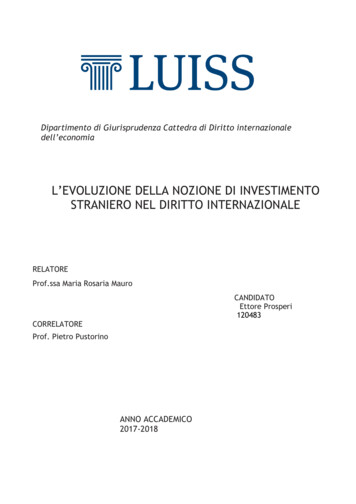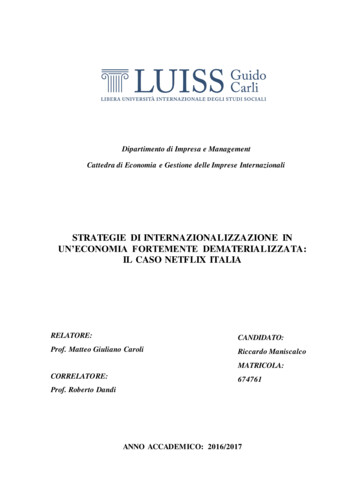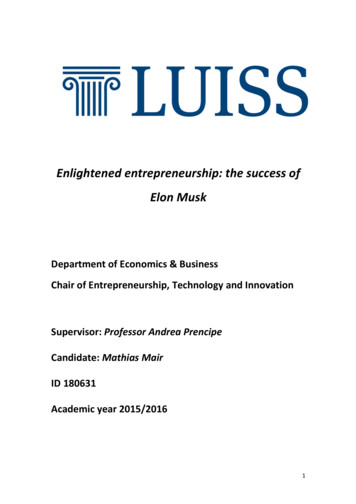
Transcription
Enlightened entrepreneurship: the success ofElon MuskDepartment of Economics & BusinessChair of Entrepreneurship, Technology and InnovationSupervisor: Professor Andrea PrencipeCandidate: Mathias MairID 180631Academic year 2015/20161
Table of contents:Introduction1- What is entrepreneurship?1.1- History of entrepreneurship1.2- Behavioural patterns in entrepreneurs1.3- Communication fundamentals in entrepreneurs1.4- Financing2- History of Musk’s rise, his life and career2.1- Early life2.2- Career beginnings: Zip2 and PayPal2.3- SpaceX: the multiplanetary dream2.4- The transportation adventure: Tesla Motors2.5- The transportation adventure: Hyperloop2.6- Solar City and Open AI3- List of Musk’s keys to success3.1- Main points of his philosophy3.2- Family, philanthropy and awards4- Conclusion5- Bibliography2
IntroductionThe purpose of this thesis is to analyse in depth the strategies, methods and actionsthat allowed Elon Musk to place himself as a top tier entrepreneur. Starting from thetrue meaning of entrepreneurship, I moved into taking to account the points incommon between Musk and what a nowadays entrepreneur needs to be capable of. Ifollowed by underlining the focal achievements reached in his career and what hemight have used to get to reach his goals, mostly his personality traits. At last Idemonstrated how he affected the culture of this days and how he rewrote thedefinition of pathfinder in the entrepreneurial world.1 What is entrepreneurship?Entrepreneurship is defined as the process of starting and running a business in astrategic way in order to make a profit from a product or service. It requires the abilityto identify opportunities to exploit a market, usually done by a team, sometimes onlyby one, entrepreneur.An entrepreneur is a person that creates, manages and develops an economic basedenterprise taking risks, usually on himself with his own private assets, but also with thecapacity of identifying and evaluate opportunities. Commonly an entrepreneur is seenas a visionary, an innovator and a business leader and they typically are in charge of acommercial undertaking, controlling human, financial and material resources requiredto exploit a business opportunity. Economist Joseph Schumpeter (1883–1950) statedthat the role of the entrepreneur in the economy is "creative destruction"–launchinginnovations that simultaneously destroy old industries while ushering in new industriesand approaches. For Schumpeter, the changes and "dynamic disequilibrium broughton by the innovating entrepreneur . [are] the norm of a healthy economy."Entrepreneurs usually operate in a system where government programs and servicesthat promote, support an mentor start-ups are included. Typically a good environmentcan provide facilities and resources, sometimes even training programs. The currently3
most important clusters of leading firms, mostly high-tech, are found in the SiliconValley, around New York and Boston and also in Singapore and Hong Kong. Since theyattract a lot of people each and every year, they just grow exponentially, puttingthemselves at the top of the chain, also fuelled by top research universities.1.1 History of terminology and meaningThe term entrepreneur was first used in 1723, today the term entrepreneur impliesqualities of leadership, initiative, and innovation in new venture design.Entrepreneur was defined as an individual who organizes and operates a business asFrench economist Jean Baptiste Say specified. However economist Richard Cantillondefined it first in his Essai sur la Nature du Commerce en general (1755), a bookconsidered by William Stanley Jevons as the cradle of political economy, but with aslight different meaning. Say thought that the figure of the entrepreneur was more asa planner while Cantillon more as a risk taker, as defined by him with those words“someone making decisions about obtaining and using the resources whileconsequently admitting the risk of enterprise”.Economist Robert Reich has called team-building, leadership, and management abilityessential qualities for the entrepreneur. Historically the study of entrepreneurshipreaches back to the work in the late 17th and early 18th centuries of RichardCantillon and Adam Smith, fundamental to classical economics.Cantillon was the first to attempt considering entrepreneurship in depth as a concept.He thought that, even if there is a clear distinction between the function of the ownerand the function of the entrepreneur, he considers the entrepreneur as a risk takerwith the final objective of maximizing the financial return by allocating the resources insuch a way to exploit opportunities.Another way to take in consideration the entrepreneur was introduced by AlfredMarshall, that believed in a multitasking capitalistic entrepreneur. He observed that in4
the equilibrium of a completely competitive market, there would not be a place forentrepreneurs as a economic activity creators.In the 20th century, entrepreneurship was studied by Joseph Schumpeter in the 1930sand other Austrian economists such as Carl Menger, Ludwig von Mises and Friedrichvon Hayek. The term "entrepreneurship" was coined around the 1920s, while the loanfrom French of the word entrepreneur dates to the 1850s.According to Schumpeter, an entrepreneur is willing and able to convert a new ideaor invention into a successful innovation. Entrepreneurship employs what Schumpetercalled "the gale of creative destruction" to replace in whole or in part inferior offeringsacross markets and industries, simultaneously creating new products and new businessmodels. Thus, creative destruction is largely responsible for long-term economicgrowth; this idea is usually an interpretation of the endogenous growth theory and thisis still a point debated in academic economics.For Schumpeter, the new industries and the new combination of inputs existing ( forexample he takes in consideration the advent of the “car” since it was a combinationof a horseless carriage and a steam engine) were all results of entrepreneurship. In the“car” example, the innovation did not require any new technology development,instead it was just a simple idea behind the spark that gave birth to the modern autoindustry. Obviously this switch between techs was not immediate, but with slowimprovements and cost reduction methods (see Ford's assembly chain idea) that tooktime.In his theory, Schumpeter considered the capitalist the one bearing all the risk, not theentrepreneur, but they were the people able to shift the production possibility curveto higher levels using their skilful mind set to seek the right innovationEven if Schumpeter highly contributed to consider the entrepreneur in his theoreticalframework, microeconomics of that time thought that resources were able to balanceand find each other with a traditional idea of price system and the entrepreneur wouldjust be treated as a small part in the greater scheme of self-balancing resources. Inthis idea the entrepreneur was just an agent of X efficiency, that is the ability of a firm5
to get maximum output from their inputs and its improvement leads to a source ofgain from trade (Leibenstein 1966).In the 2000s, the term entrepreneurship collected a much broader concept of socialattitude, in which environment, humanitarian and political goals go alongside withbusiness. It also has been extended to specify a new kind of mind set, a mind able tolead, plan, organize and improve resulting in entrepreneurial initiatives.According to the founder of Global Entrepreneurship Monitor, Paul Reynolds, in therecent years it is becoming a common experience for developed countries citizens tobecome self-employed, becoming a major driver of economic growth. Thoseentrepreneurial activities, that can differ substantially depending on the type ofbusiness in which they operate, are all leading to the same objective, growth.1.2 Behavioural patterns in entrepreneursThe behavioural patterns that define an entrepreneur nowadays are many andcommon for most theorists’ definitions. In the last decade many studies have tried toassess the psychology and traits of entrepreneurs and since entrepreneurship is such awide concept, it has to be studied from different perspectives. The figure of theentrepreneur is widely observed as an innovator with strong leadership, managementability and a great team building capacity, usually enriched with the talent of a gooduse of new tech; but one aspect is the one of being a risk taker. An entrepreneur, ifasked to put his career on the line for the cause of an idea, is most likely to acceptthose conditions of financial insecurity because his beliefs are stronger than that. Astudy of 2014 held at the ETH Zurich showed that entrepreneurs, compared to typicalmanagers, have a higher decision making efficiency and take usually more risks thantheir counterpart. Also a main trait of entrepreneurs is that they are opportunistic, inthe sense that they can notice what others overlook without paying attention to smalldetails and are able to profit from their recognition capacity.The entrepreneur as an innovator creates a “wave of creative destruction” (asSchumpeter said) responsible for “the doing of new things or the doing of things thatare already being done in a new way” by starting a cycle of innovation-hype-imitation-6
stability-innovation that repeats itself for each new product/service. Their ability toinnovate, introducing new tech, new products or services, increase efficiency inworkers productivity, have strong negotiating skills and consensus-forming ability arethe core traits for a successful entrepreneur. In contrast to the say that everyone canbecome an entrepreneur, many academics think that the predisposition could befound directly in the DNA, becoming a matter of genes and an innate ability.Of course, also the environment and the social composition in which an individual isformed influences significantly its personality, so that when faced with a givensituation it can trigger its strengths and weaknesses. Personality is a system that isrelated to the environment and it seeks explanation to the complex transactionconducted by both, traits and attitudes, a deeply investigated subject by psychologists.According to Jesper Sorensen, peers are one of the greatest influence variable, theystimulate entrepreneurialism by showing that success is achievable, inspiring thethought “If he can do it, why can’t I?”. Past experiences drive an entrepreneur to whathe has become now, so to say his education, if he has been unemployed, if he hasfaced many problems and how he overcame those problems.1.3 Communication fundamentals in entrepreneursNowadays successful entrepreneurs need to have a fluent and effectivecommunication skill set within their firm and most important externally, withinvestors, customers and other firms. They need to communicate a vision to theirfollowers in a proper way for them to really believe in it, to make them feel as theproject is just there ready to get taken, making it achievable and giving a sense ofpurpose and encouraging commitment. Since this is critical requirement for afavourable outcome in the business world, it is needed a charismatic leader that caninspire the masses. Jayson Demers, founder and CEO of AudienceBloom states “Youcan be the best at what you do, but if you’re not communicating effectively withclients, staff and the market, then you’re missing opportunities.”7
And today many entrepreneurs have to communicate face-to-face and many areconcerned for the upcoming generation since most of the correspondence is donethrough emails and text messages. Richard Branson, head of Virgin, says that when itcomes to business “the ability to conduct a telephonic and face-to-face conversationintelligently and personably remains an essential asset and only comes with practice.Being capable of confidently holding a conversation is as important as making aconfident, strong first impression on someone you want to do business with.”Nonverbal elements in speech such as the tone of voice, the look in the sender's eyes,body language, hand gestures, and state of emotions are also importantcommunication tools. From a study of the UCLA, 55% of the meaning in face-to-faceinteractions are conveyed non-verbally, so body language in general is accountable formore than half of an articulation. Body awareness is considered one of the key pointsin public speaking courses, taking in consideration posture, expressions and gesturesand it’s not a surprise that those lessons are having a booming increase in demand.Developing those soft skills are a need for success and for the career an entrepreneurbut necessitate time to develop in a proper way.The last but not least part of communication is listening. Being able to understand theneeds, the concerns and the critiques from the counterpart can be a cardinal requisiteto have a high customer satisfaction.1.4 FinancingEntrepreneurs are able to gather resources necessary for their projects if they raisecapital in an effective way and this is matter of entrepreneurial financing. Afterassessing how much is needed for their idea to be ready to go, to grow and togenerate a positive cash flow, how to raise this capital is the fundamental question.The riskiness of starting a business is very high, actually only one out of seven start-upscan be considered successful, so having a sufficient monetary base for eventualexpenditures due to problems along the path to the foundation of the business is key.8
There are many methods to raise this capital: bootstrapping, friends and family, banks,business angels, venture capitalists, hedge funds and crowdfunding.Bootstrapping happens when entrepreneurs decide to incur in personal credit debt sothat they don’t have to share their equity with investors. While bootstrapping involvesincreased risk for entrepreneurs, the absence of any other stakeholder gives theentrepreneur more freedom to develop the company. Many successful companies, forexample Dell Computer and Facebook, started by bootstrapping.Friends and family usually are the first to whom the entrepreneur asks for help, but itis just adequate enough for a small business, and also it is not recommended becausemoney is considered the number one cause for relationships break-ups.Banks as above are not really adequate for bigger businesses, but they actually can bea big part in the investing strategy even if usually require a position inside the companyfor the decision making.Business angels are affluent individuals who provide capital for a business start-up,usually in exchange for convertible debt or ownership equity. A small but increasingnumber of angel investors organize themselves into angel groups or angel networks toshare research and pool their investment capital, as well as to provide advice to theirportfolio companies.Venture capitalists make a form of financing that is provided by firms or funds to small,early-stage, emerging firms that are deemed to have high growth potential, or whichhave demonstrated high growth. Venture capital firms or funds invest in these earlystage companies in exchange for equity.Hedge funds are investments fund that pools capital from a limited number ofaccredited individuals or institutional investors and invests in a variety of assets, oftenwith complex portfolio-construction and risk-management techniques.Crowdfunding is a very recent way of raising capital and is an alternative way forfunding start-ups by gathering a large number of individual investors.9
2 History of Musk’s rise, his life and careerHe is worth over 12 billion dollars, has created game changing businesses like Paypal,Tesla Motors and Space X and has been defined as the nowadays real life Iron Man,Elon Reeve Musk, the South African business magnate, engineer, inventor andvisionary.2.1 Early lifeElon was born in Pretoria (RSA) in 1971 from Errol Musk, a South Africanelectromechanical engineer, and from Maye Haldeman, a Canadian model and nowdietician. Both his parents are college laureate, Errol in engineering and Maye indietetics, but they actually met in High School. His paternal grandmother was British,and he also has Pennsylvania Dutch ancestry. His grand-parents, Joshua and WynHaldeman, were adventurous and flew the family around the world in a prop plane in1952. After his parents divorced in 1980, Elon lived mostly with his father in locationsin South Africa.Older brother of his two siblings, Kimbal (1972), and Tosca (1974), he began at the ageof 10 to study vividly computer programming and when he was only 12 years old, hewas able to sell a video game he created, Blastar, to the magazine “PC and OfficeTechnology” for about 500 . Already well ahead for his age, Elon was often bulliedthroughout his childhood by his school companions, in fact he was once recovered inthe hospital due to severe beatings. Initially he attended private schools, but then hegraduated from the Pretoria Boys High School and immediately moved to Canada in1989 after obtaining citizenship due to his mother Maye, Canadian born, that followedhim with the rest of his children an year later. That year alone in Canada, even ifbacked-up by his wealthy family, gave him a strong independency, that build up hisself-esteem. He was then accepted into Queen’s University in Ontario for hisundergraduate studies, but after two years he transferred to the University ofPennsylvania and received a Bachelor of Science degree in physics and a Bachelor of10
Science in economics. While there, after deciding to stay one more year to continuestuding, Elon and Adeo Ressi, a fellow student, rented a fraternity house, using it as anunofficial nightclub. Later in 1995, Musk moved to California to study at StanfordUniversity for his PhD in applied physics and material science, but left after only twodays to pursue his entrepreneurial aspiration. He wasn’t even 25 yet.2.2 Career beginnings: Zip2 and PayPalElon and his brother Kimbal decided to rent an office which they used as both houseand working space to start their own software company in 1995. Zip2, the name of thecompany, was founded thanks to the money given by their father Errol and began todevelop quickly in those years of computer rise.Zip2 primarily provided and licensed online city guide software to newspapers such asThe New York Times and The Chicago Tribune. Elon Musk was appointed the ChiefTechnology Officer. Zip2 trademarked “We Power the Press” as its official slogan andcontinued to grow. By 1998, the company had partnered with about 160 newspapersto develop guides to cities, either locally or at full scale. In 1999 it was acquired byCompaq for 307 million, Musk received 7% of this sale, earning him 22 million.In the spring of 1999, Elon decided to reinvest 10 million by co-funding an onlinefinancial services and email payment company named X.com. In 2000, they mergedwith Confinity, a company that provided similar services, and decided to change thefocus of the company to only the money transfer service, calling themselves PayPal.It expanded rapidly throughout the year driven mainly by viral marketing campaignsuntil company executives decided to take PayPal public in 2002. Paypal's IPO listedunder the ticker PYPL at 13 per share and ended up generating over 61 million. Laterthat year, eBay acquired it for 1.5 billion and since Musk was the company’s greatestshareholder, he received 165 million.11
2.3 Space X: the multiplanetary dreamAfter his cash-out from PayPal, Elon Musk was already thinking on what he was goingto do next. He had various ideas in mind, many problems that he wanted to solve notfor himself, but rather for the whole humankind. He wanted to do something differentand not directly related to the internet, his main field, and decide to begin to explorenew projects. As he said in a recent interview for Khan Academy, he was in America,the land of explorers and this gave him the spark to reach out of his comfort zone.He had three main ideas in mind: first he wanted to make people care more for theenvironment, make them aware and give them the instruments to pollute less; secondpoint is related to the environment but in a different way. Musk wanted to improvethe transportation systems, make them more efficient, not dependent from fossil fuel,and so pointing to electric energy. Third point, he firmly believed that humans,proceeding at this tech improvement rate, would necessarily need to become amultiplanetary species, as an important step in expanding, if not preserving, theconsciousness of human life and to do so he wanted to reignite space exploration.So in 2001, Musk conceptualized “Mars Oasis”, a project to land an experimentalgreenhouse on the surface of Mars in an attempt to regain public interest in spaceexploration and to increase the budget of NASA. He decided then to travel to Russiawith Adeo Ressi, his college partner, and an aerospace expert to begin a series ofmeetings to buy rocket that would bring the payload to Mars. Musk wasn’t reallyconsidered by the companies for his lack of rocket knowledge and so the first meeting endedwithout any progress. Musk felt that it was his right to be part of this idea, so he read andstudied various books on the subject.In 2002 the group met again with Kosmotras, and were offered one rocket for 8 million, however, this was seen by Musk as too expensive; Musk consequently stormedout of the meeting. On the flight back from Moscow, Musk realized that he could starta company that could build the affordable rockets he needed.Using approximately 100 million from his PayPal cash-out, Musk founded SpaceExploration Technologies or simply SpaceX in June 2002. The newly CEO and CTO12
calculated that the raw materials for building a rocket actually were only 3 percent ofthe sales price of a rocket at the time. By applying vertical integration and the modularapproach from software engineering, SpaceX could cut launch price by a factor of tenand still enjoy a 70-percent gross margin, and vertical integration’s reason was Musk'sbelief that reusable rockets couldn't be built with components from pre-existingaerospace suppliers. The first launch of the Falcon 1, name given to remember theMillennium Falcon from Star Wars, costed just 6 million, while usually the averagecost at that time was about 25 million. Musk had been able to lower to a quarter ofits actual cost the launch by building the smallest useful orbital rocket instead ofrisking bankruptcy for his company with a more complex rocket that might have failed.Even if the path was not easy and nearly led the company to failure, in 2006, afterFalcon 9, a newly developed rocket, had a successful launch, SpaceX was awarded acontract from NASA to continue the development and test of the SpaceX Falcon 9vehicle and Dragon spacecraft in order to transport cargo to the International SpaceStation. In 2008, 1.6 billions was the reward NASA Commercial Resupply Servicesprogram gave to SpaceX for 12 flights of its Falcon 9 rocket and Dragon spacecraft tothe Space Station. Musk was living in great distress, working day and night to solve hiscompany’s problems, until with the funds of NASA he was able to focus again of hislong term scope, the human colonization of Mars.On 22 December 2015, SpaceX successfully landed the first stage of its Falcon rocketback at the launch pad. It was the first time in history that such a feat had beenachieved by an orbital rocket and it was a significant step towards rocket reusability,lowering the costs of access to space. This first stage recovery was replicated severaltimes in 2016 by landing on an autonomous spaceport drone ship, an ocean basedrecovery platform. In late 2016 SpaceX intends to launch its Falcon Heavy rocket,which will be the most powerful operational rocket in the world.In 2015, the company asked permission to the federal government to begin testing fora project that aims to build a constellation of 4000 satellites capable of beaming theInternet to the entire globe, including remote regions which currently have notinternet access.13
Musk stated in June 2016 that the first unmanned flight of the larger Mars ColonialTransporter (MCT) spacecraft is aimed for departure to the red planet in 2022, to befollowed by the first manned MCT Mars flight departing in 2024. He has expressed hisinterest in someday traveling to the planet, stating "I'd like to die on Mars, just not onimpact." To achieve it, Musk plans to establish cargo flights to Mars, getting the firstdelivery there by 2018. A rocket every two years or so after that could provide a basefor the people arriving in 2025 after a launch in 2024. Musk believes that by 2035 atthe latest, there will be thousands of rockets flying a million people to Mars, in orderto enable a self-sustaining human colony.Figure 1: Rocket launches per year operated by SpaceXSource: Wikipedia article on SpaceX launches14
2.4 The transportation adventure: Tesla MotorsTesla Motors was founded in 2003 by Martin Eberhard and Marc Tarpenning. Thename is of course inspired by Nikola Tesla, a Serbian inventor that wanted to changethe world at the beginning of the XX century.Elon Musk was the controlling investor in the first financing round in 2004 and becamea chairman in the board of directors as well as an fundamental actor in the operationsthanks to the 7.5 million spent in the project. He truly believed in Tesla and wanted tochange the public opinion over electric cars. The primary goal was to start with apremium, high-end vehicle, to catalyse the attention and attract affluent investors, asto emulate typical technological-product life cycles and initially enter the automotivemarket with an expensive. As the company, its products, and consumer acceptancematured, it had to move into larger, more competitive markets at lower price points.After having consulted on the strategy, there had been other rounds of investmentwere Musk contributed substantially, always leading in the capital invested and able toattract friends in the tech community as Sergey Brin and Larry Page, but the actual firstmodel wasn’t yet in production. In 2008, following the financial crisis, Musk assumedleadership and became CEO, avoiding bankruptcy by firing 25% of Tesla employees.The Tesla Roadster came out in 2006, but just as a prototype, and finally in 2008 theproduction began and Musk had decision making for the product design at a detailedlevel.The Roadster is an all-electric sports car that was able to raise 187 million, but wasn’tsold as much as wanted, just 147 cars. The awareness in the market was spread. Manypeople were finally understanding that electric cars were not just slow and boring cars,but could also attach to their environment-friendly etiquette the emotion that couldgive a real sports car. Later on in 2009, the next model of Tesla was announced, theModel S, bringing a huge wave of hype for Tesla, so much that Daimler AG decided toacquire 10% of Tesla, giving them the boost needed continue develop the model S.In June 2009, Tesla had is turnaround. First it was approved the receiving of a lowinterest loan of 465 million by the United States government as an incentive to15
produce non-polluting vehicles and to further develop the battery technology. Then, atthe end of the month, the 29th, Tesla Motors launched its initial public offering (IPO)raising 226 million for the company. After Ford Motor Company in 1956, Tesla wasthe first American car maker to go public.It was time for the company of Palo Alto to proceed to the next model in its businessstrategy. After the low-volume high-price Roadster, it was the Model S time with itsmid-volume mid-price. Finally the delivering of cars began in 2012.Model S was a huge success for Tesla, so much that car market competitors began feelthe pressure and began to enter in the alternative-fuel market. They were amazed onhow a small Californian start-up, run by people who knew nothing about car business,had such success. In order to allow quick charge for the new Model S, Tesla began tobuild a network of fast charging stations, that had to be spread all over to allowcostumers a quick and efficient way to charge in case of long journeys.The business was running good, Tesla had many collaborations with other car makers(Mercedes, Smart, Toyota) and decided to make available to everyone their patents.The reasons expressed for this stance included attracting and motivating talentedemployees, as well as to accelerate the mass market advancement of electric cars forsustainable transport. In the same year, Musk reduced his salary to one dollar. And,similar to Steve Jobs and others, the remainder of his compensation was in the form ofstock and performance-based bonuses.In 2015 it was the turn of the Model X to be put in production. Still being a mid-volumemid-price vehicle, but aiming at the SUV market. Well accepted after his first days,Tesla wanted to become a company with almost 100% of vertical integration,controlling all the supplies needed for their cars. That’s why they decided to establishin Nevada, the GigaFactory, an immense industrial site completely focused in theproduction of batteries. The plant, with the cost of about 5 billion, would employ6,500 people and reduce Tesla Battery costs by almost 30%. The state of Nevadahelped to make this come true through a 1.3 billion tax incentive.16
In March 2016, Tesla revealed his latest model, Model 3, the high-volume low-price carthat Musk wanted to be named Model E, but was negated by the fact that Ford alreadyowned that copyright. Musk wanted the first three models to spell S-E-X but settledwith "S3X”. However, the digit "3" will be stylized like three horizontal bars, making itindistinguishable from the "E" in Tesla's logo.Apart from Musk’s strange naming criteria, Model 3 has been the biggest one weekl
2- History of Musk's rise, his life and career 2.1- Early life 2.2- Career beginnings: Zip2 and PayPal 2.3- SpaceX: the multiplanetary dream 2.4- The transportation adventure: Tesla Motors 2.5- The transportation adventure: Hyperloop 2.6- Solar City and Open AI 3- List of Musk's keys to success 3.1- Main points of his philosophy
